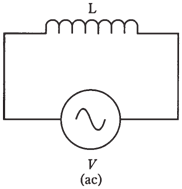Coils and alternating current:
Assume that you change the voltage source, connected across coil, from direct current to alternating current. Imagine that you can vary the frequency of the alternating current, from hertz to hundreds of hertz, then kilohertz, then megahertz.

Figure-- A coil connected across a source of ac.
At first, the alternating current will be high, just as it is with direct current. But the coil has a certain amount of inductance, and it takes some time for the current to establish itself in coil. It depends on how many turns there are, and on the core is air or a ferromagnetic material, you will reach a point, as the alternating current frequency increases, when coil starts to get sluggish. That is, the current will not have time to get established in coil before the polarity of voltage reverses.
At high alternating current frequencies, the current through the coil will have difficulty following the voltage placed across coil. Just as coil begins to "think" that it is making a good short circuit, the alternating current voltage wave will pass its peak, go back to zero, and then try to pull electrons the other way.
This sluggishness in the coil for alternating current is, in effect, similar to direct current resistance. As the frequency is raised higher, the effect gets more and more pronounced. Eventually, if you keep on increasing frequency of the alternating current source, the coil will not even begin to come near establishing the current with each cycle. It will behave like a large resistance. Hardly any alternating current current will flow through it.
The opposition which the coil offers to alternating current is called as inductive reactance. It, like resistance, can be measured in ohms. It can vary just as resistance does, from near zero to a few ohms to kilohms or megohms.
Like resistance, inductive reactance affects the current in an alternating current circuit. But, unlike simple resistance, reactance changes with the frequency. And the effect is not a decrease in the current, although in practice this will happen. It is a change in the way current flows with respect to the voltage.